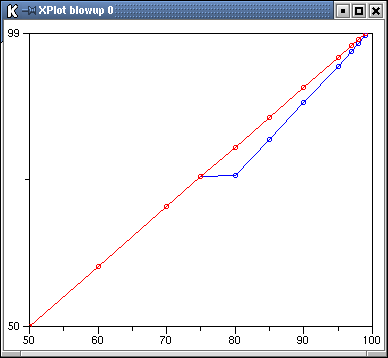I want to know how accurate CBQ can split the bandwidth when you use different rates and provides no weight parameter.
Used script (download)
RATE_TOT=100 # In KiloBytes/Sec RATE1=90 RATE1=`expr $RATE_TOT \* $RATE1` RATE1=`expr $RATE1 / 100` RATE2=`expr $RATE_TOT - $RATE1` RATE_TOT=$RATE_TOT`echo kbps` RATE1=$RATE1`echo kbps` RATE2=$RATE2`echo kbps` echo rate_tot: $RATE_TOT echo rate1: $RATE1 echo rate1: $RATE2 PRIO1="prio 3" PRIO2="prio 3" IP=kriek DEV="dev eth0" OPTION="allot 1514 maxburst 20 avpkt 1000" tc qdisc del $DEV root tc qdisc add $DEV root handle 10: cbq bandwidth 10mbit avpkt 1000 tc class add $DEV parent 10:0 classid 10:2 cbq bandwidth 10mbit rate $RATE_TOT $OPTION prio 3 bounded tc qdisc add $DEV parent 10:2 handle 20: cbq bandwidth $RATE_TOT allot 1514 avpkt 1000 tc class add $DEV parent 20: classid 20:10 cbq bandwidth $RATE_TOT rate $RATE1 $OPTION $PRIO1 tc class add $DEV parent 20: classid 20:20 cbq bandwidth $RATE_TOT rate $RATE2 $OPTION $PRIO2 tc filter add $DEV parent 10: protocol ip prio 3 handle 1 fw classid 10:2 tc filter add $DEV parent 10: protocol ip prio 3 handle 2 fw classid 10:2 tc filter add $DEV parent 20: protocol ip prio 3 handle 1 fw classid 20:10 tc filter add $DEV parent 20: protocol ip prio 3 handle 2 fw classid 20:20 iptables -F iptables -X iptables -N acc_0 iptables -N acc_1 iptables -A OUTPUT -t mangle -p tcp --dport 2000 -j MARK --set-mark 1 iptables -A OUTPUT -t mangle -p tcp --dport 2001 -j MARK --set-mark 2 iptables -A OUTPUT -p tcp --dport 2000 -j acc_0 iptables -A OUTPUT -p tcp --dport 2001 -j acc_1
| RATE1 | RATE2 | RATE1/RATE_TOT | |
|---|---|---|---|
| Theory | Tests | ||
| 50 | 50 | 50% | 50% |
| 60 | 40 | 60% | 60% |
| 70 | 30 | 70% | 70% |
| 75 | 25 | 75% | 75% |
| 80 | 20 | 80% | 75.3% |
| 85 | 15 | 85% | 81.3% |
| 90 | 10 | 90% | 87.5% |
| 95 | 5 | 95% | 93.5% |
| 97 | 3 | 97% | 96.0% |
| 98 | 2 | 98% | 97.3% |
| 99 | 1 | 99% | 98.7% |

The traffic is shaped and this is allmost perfect done.
When you provide no weight parameter, the system chooses a default one. When you execure tc -s -d qdisc, you can see that the choosen weight is equal to the rate. And this gives good results. This is also the conclusion of the other page about splitting the traffic in different classes.
I deleted the qdisc 20: and attached the classes to the parent class 10:1. The results was clear. Each class gets 50% of the bandwidth, but the total bandwidth is bounded to 100kbps. So the traffic is not split in the different classes.
When you attach the filtes to 10: and put the traffic directly in 10:10 and 10:20, the bandwidth is totally not managed. Each class gets 50% of the full bandwidth (10mbit).
Used script (download)